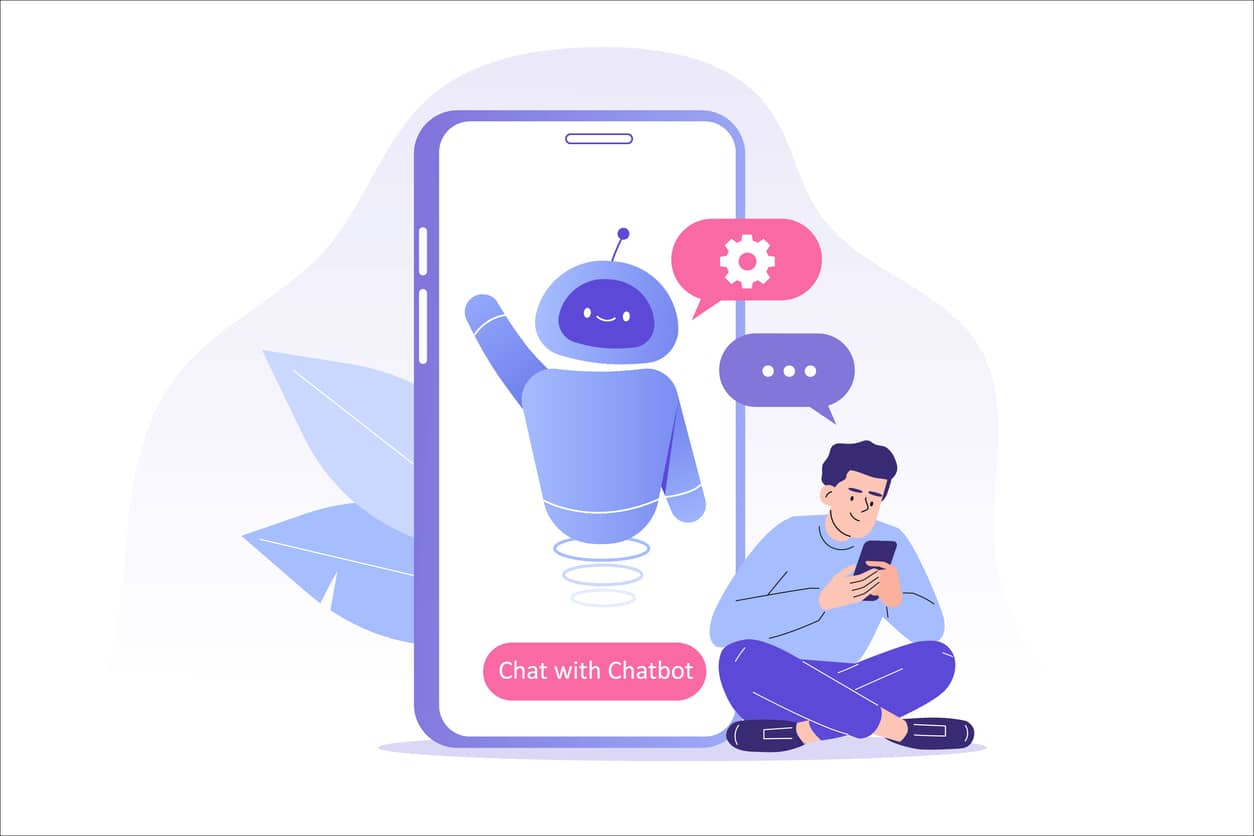Where does a chatbot get its information?
You may have heard much about chatbots, but still don’t fully understand where they get their information. Let’s delve into the intricacies of these virtual assistants.
Internal Database
The internal database is like the beating heart of chatbots – it’s their primary source of info. Think of it as a digital storage unit packed with tons of helpful stuff: ready-made answers, frequently asked questions and all kinds of data about products or services. This database is like the chatbot’s memory – everything is neatly organized to help it quickly and accurately respond when you chat.
So, when you ask the chatbot for help or info, it smoothly taps into this internal data stash. This clever process ensures you get fast, accurate, and spot-on info, making the chatbot super efficient and effective in giving you a smooth and satisfying experience. The internal database is the brainpower that helps chatbots handle all sorts of questions quickly and precisely.
Web Search
Chatbots do more than use their own info – they can also dive into the vast world of the internet through web searches. This feature lets chatbots explore and get real-time information from the web, ensuring users know what’s happening in a specific area. Using algorithms and search tricks, chatbots smoothly move through the vast digital world, grabbing info from various online sources.
Chatbots can provide quick, accurate, and on-point info, whether keeping an eye on industry trends, staying in the loop on current events, or finding the latest details for a user’s question. This flexibility lets chatbots go beyond their internal databases, offering users a wider range of knowledge for better interactions and keeping them updated in the always-changing digital world.
API Integration
To make chatbots even more intelligent, they team up with external apps using APIs– like digital connectors. APIs act as bridges, letting chatbots talk and work with other software, platforms, or databases outside their system. This teamwork helps chatbots break free from their internal info limits and tap into a mix of external sources.
Using APIs, chatbots can grab info from different platforms, apps, and databases, forming a friendly connection between the chatbot and the broader digital world. This partnership ensures users get a full-service experience, as chatbots use many data points to give accurate, current, and contextually relevant info. Thanks to API teamwork, chatbots can adapt, evolve, and offer users a more lively and versatile interaction beyond relying on their internal databases.
Natural Language Processing (NLP)
Natural Language Processing (NLP) is a fancy term in artificial intelligence that makes chatbots talk and understand human language better. It’s like giving chatbots the ability to read sentences and understand the meaning behind the words, just like humans do when they talk. NLP helps chatbots catch your words’ context, feelings, and intentions, turning plain text into valuable insights.
NLP goes through a few steps:
- Breaking sentences into words or phrases (tokenization)
- Analyzing the sentence structure
- Understanding the meaning
- Interpreting the overall conversation
With these steps, chatbots with NLP skills can know what you’re asking, pick up on language details, and respond in a way that feels like a natural chat.
Why is NLP so important for chatbots? It’s like a translator between the organized data in a chatbot’s brain (internal database) and how people talk, which is often messy and unstructured. This cool tech lets chatbots chat with users in a more human-like way, getting what you mean even if your words aren’t perfect. It’s the secret sauce that helps chatbots be intelligent, friendly conversation partners, turning them from just information keepers into dynamic, understanding pals.

User Database
Chatbots dig into user databases to give you the best help possible – treasure troves full of valuable details about each person. These databases are like carefully organized collections holding insights into users’ likes, behaviors, and past chats with the chatbot. By smartly using and understanding this stored data, chatbots create an experience that’s more than just standard responses – personalized to fit each person.
In these user databases, detailed profiles are kept, including things like what users bought before, common questions, preferred ways of communication, and specific preferences mentioned in previous chats. With all this info, chatbots become like virtual helpers, getting the right information fast and tailoring responses to suit each person’s unique needs.
Using this goldmine of user data lets chatbots suggest personalized recommendations, answer questions before they’re asked, and adapt responses to specific likes.
Chatbots become intuitive assistants, making your experience smoother and more tailored. This personal touch makes conversations more accessible and builds a sense of connection and familiarity, strengthening the bond between users and chatbots. Using user databases lets chatbots step beyond standard interactions, offering personal help that feels like having a knowledgeable and attentive human assistant.
Machine Learning
Far from being static entities, chatbots embody a dynamic and evolving nature, continuously refining their capabilities through a perpetual learning process. At the heart of this evolution lies the imperative aspect of training chatbots on user-specific data, a practice that holds the key to their continual improvement. The process of how to train chatbot on your own data is pivotal, as it involves the strategic incorporation of bespoke datasets, enabling chatbots to glean insights and adapt in real-time to user interactions.
Machine learning, a transformative facet of artificial intelligence, serves as the engine propelling this evolutionary journey. Machine learning enables chatbots to discern patterns, allowing them to comprehend the intricacies of user behavior. Chatbots become adept at anticipating user needs and optimizing their responsiveness by analyzing historical interactions and identifying recurring themes.
The continual learning process engendered by machine learning is foundational to chatbots’ effectiveness in furnishing accurate and relevant information. As chatbots encounter diverse queries and engagement scenarios, they iteratively refine their understanding, ensuring that responses become increasingly nuanced, context-aware, and aligned with user expectations. This adaptability is paramount in a dynamic digital landscape where user preferences, language nuances, and industry trends constantly evolve.
The synergy between machine learning and chatbots creates a symbiotic relationship where each user interaction contributes to refining the chatbot’s knowledge base. This perpetual learning enhances the chatbot’s effectiveness in providing precise and pertinent information and positions it as an intelligent and agile conversational partner. The result is a chatbot that responds to user queries and actively evolves, ensuring a sustained and elevated user experience.

How does a chatbot retrieve this information?
Delving into the mechanics of information retrieval and understanding how a chatbot retrieves this information unveils a nuanced and intricate process that underscores the agility and intelligence of these virtual assistants. As we’ve previously explored the diverse sources from which chatbots draw information, the focus now shifts to the methodologies employed to seamlessly access and present this data.
At the core of a chatbot’s information retrieval mechanism are predefined algorithms meticulously crafted to navigate the vast landscape of data stored in internal databases, external APIs, and user profiles. These algorithms serve as the chatbot’s guiding principles, facilitating efficient and targeted retrieval of relevant information based on the user’s query.
Sophisticated search capabilities further augment the chatbot’s repertoire, allowing it to traverse the digital expanse with finesse. This entails employing advanced search algorithms, semantic analysis, and contextual understanding sifting through vast datasets. The chatbot, equipped with these capabilities, can discern patterns, prioritize information, and present users with responses that align with the explicit content of their queries and the underlying context.
Real-time learning is pivotal in this retrieval process, ensuring the chatbot’s adaptability to evolving user needs. Through continuous learning from user interactions, machine learning algorithms empower chatbots to refine their understanding of language nuances, user preferences, and industry dynamics. This dynamic learning loop enhances the chatbot’s responsiveness, enabling it to stay abreast of the latest trends and provide users with up-to-the-minute information.
A chatbot’s information retrieval process is a multifaceted orchestration of algorithms, search capabilities, and adaptive learning mechanisms. It harmonizes these elements to deliver timely, accurate, and contextually relevant responses, embodying the sophistication required to meet the diverse and dynamic demands of user interactions in the digital landscape.

Is data protection always guaranteed?
Ensuring the security of customer data is paramount in the age of advanced technology. While chatbots are designed with robust security measures, businesses must implement stringent data protection protocols. This involves encrypting sensitive information, regularly updating security measures, and adhering to industry standards.
In conclusion, understanding where a chatbot gets its information provides insights into the intricate workings of these virtual assistants. Chatbots are well-equipped to assist us all effectively, from internal databases to web searches, API integrations, and advanced technologies like NLP and machine learning. As businesses embrace this technology, exploring what is a chatbot used for, the best ai chatbot app, and knowing how to make chatbot undetectable, and how to check if something was written by a chatbot becomes crucial to build and maintain trust with customers.





